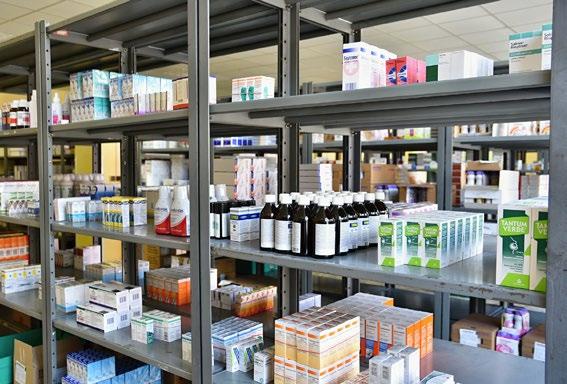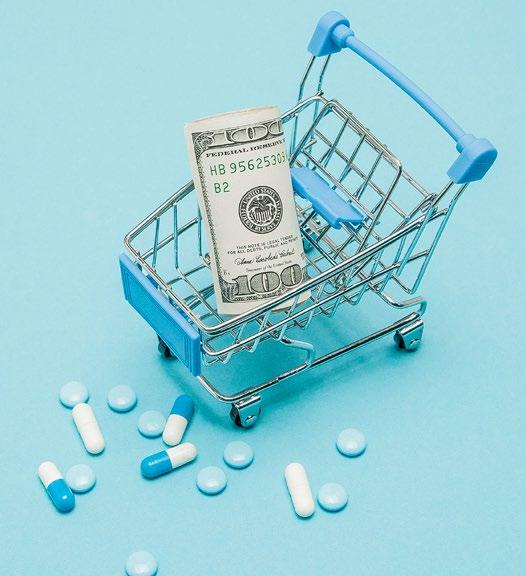
7 minute read
PHARMACY DESERTS
by SIPC
PHARMACY DESERTS: A VICIOUS
CYCLE THREATENS TO BOTTLENECK VACCINE ROLLOUT
Advertisement
Written By Nick Bonds, Esq.
OOne of the brightest spots in the headlines over the past few months has been the success of several vaccine candidates to inoculate the world against the scourge of the coronavirus pandemic. These vaccines have been developed at an unprecedented pace in the face of an unprecedented public need. They are truly a marvel of modern medical technology, and likely our most direct path back to some semblance of normalcy. Even so, the promised miracle of these vaccines cannot be fulfilled until the doses find their way into the arms of the public. As dramatic efforts are being undertaken to ensure adequate supplies of vaccines, the rollout of a mass vaccination campaign is impeded by logistics.

Individuals otherwise eligible to receive the vaccine struggle to schedule appointments, are discouraged by long lines at administration sites, or they struggle to make their way to one such site to begin with. These are all problems at least partially amplified by a dilemma that has been quietly festering within the healthcare industry for years: the pharmacy desert.
The “pharmacy desert” is a companion of the “food desert” – a concept utilized by the U.S. Department of Agriculture to denote a geographic area with insufficient access to fresh, healthful food. Residents living in these food deserts experience a number of negative impacts from this phenomenon, including significantly higher food expenses, and substantially inadequate nutrition, as well as a myriad of related detrimental health and developmental complications. These food deserts disproportionately impact low-income and minority communities, in both urban and rural settings.
In 2014 article, Dr. Dima M. Qato and her co-authors expanded on this concept, coining the term “pharmacy desert” to describe a parallel anomaly in the health care space.1 Through their research, they identified a trend in areas around Chicago where whole communities were losing access to pharmacies.
Residents of these pharmacy deserts found themselves with little or no avenue to obtain not just prescription drugs, but also the other myriad services for which had come to depend upon their local pharmacy: over-the-counter products, diagnostic services, even a level of preventive and urgent care services. For some in these low-access areas, even a pharmacy more than two miles away could be completely inaccessible in an urban setting where individuals lack readily available personal vehicles or efficient public transportation.
For rural pharmacy deserts the distances may be even greater, with the nearest pharmacy upwards of ten miles away. Simply being unable to physically reach a pharmacy could make it impossible to complete a course of pharmaceutical treatment.
While the 2014 article focused on Chicago, the trend they detailed were troubling. About 32% of the census tracts, they observed were located within a pharmacy desert, translating to roughly a million Chicagoans with little to no ability to easily fill their prescriptions at a pharmacy.2
Development of these pharmacy desserts is driven by a number of factors. Lower income and minority neighborhoods tended to have lower rates of insurance coverage and pharmacy providers in those areas experienced lower rates of reimbursement for prescription drug claims.
Smaller pharmacy operating on relatively thin margins struggle to stay afloat, with many selling out to larger chains or closing entirely. Areas with higher reliance on Medicare and Medicaid
also tended to have lower rates of reimbursement for prescription drugs, and saw their local pharmacies going dark.
While the hardships faced by smaller pharmacies led to increased consolidation by the massive chain stores like CVS, Duane Reade, and Walgreens, these pharmaceutical behemoths were not immune to the negative economic forces. These chains have resorted to closing substantial numbers of their locations in areas where they are less profitable, thus expanding the radius of the pharmacy deserts.
On top of relatively mundane market forces, the companies administering state Medicaid plans have made changes that effectively cut off access for individuals relying on Medicaid for prescription drug coverage.
As detailed by the Chicago Tribune, near the end of last year, Aetna drooped Walgreens from its pharmacy network, meaning about 400,000 Medicaid members could no longer fill their prescriptions at a Walgreens location. These new holes in prescription drug available effectively riddled Illinois with a new swath of pharmacy deserts just as the economic impacts of the coronavirus pandemic drove more and more pharmacies to shutter their doors, spurring the cycle of contributing factors faster still.
For self-funded plans, these developments are especially troubling. Prescription drug spending is a huge expense for many plans, particularly those with older employee populations – the same populations that are at elevated risk of infection by the coronavirus.
The expansion of pharmacy deserts serves to drive up prescription drug prices. Additionally, many plans are already struggling to contend with the cost of coronavirus testing, a service frequently performed at local pharmacies. For populations in a pharmacy desert, the associated cost of this testing – which selffunded plans are mandated to cover – will also continue to be pushed ever higher.
Perhaps most importantly, the efforts to vaccinate the public are also being exacerbated by pharmacy deserts, blunting the impact of one of our key weapons to address this public health struggle. Pharmacies like CVS and Walgreens are two of the biggest vectors through with many are likely to seek their coronavirus vaccine.

For individuals living in a pharmacy desert, this avenue may be prohibitively difficult, thus delaying distribution of the vaccine to some of our most vulnerable populations. The virus has already hit lower income communities the hardest, and areas caught in a pharmacy desert will struggle to share equitably in the most effective solution.
Urban communities tend to be hot spots of viral transmission. Where these hot spots overlap with a pharmacy desert, not only are efforts at testing and treating that community greatly hindered, on top of the effort to vaccinate that community being hamstrung as well.
In other words, a pharmacy desert becomes a vaccine desert, and these communities are hit doubly as hard. This perpetuates a vicious cycle of ever-burgeoning risk alongside the intractability of the underlying problem: the economic havoc wrought by the pandemic squeezes out small, local pharmacies.
The reduced pharmacy access expands the radius of pharmacy deserts. And the diminishing access to pharmacies and all the services they offer (e.g., vaccinations) intensifies the health and financial impacts of the pandemic, ad infinitum. This quandary will inevitably begin having an impact on self-funded plans covering individuals in these urban pharmacy deserts similar to the struggles faced by plans whose participants are in more remote rural areas.
As participants find themselves with ever more limited access to pharmacies, the plan’s spending on prescription drugs will begin creeping higher. Furthermore, as the pandemic rolls on and plans find themselves covering more and more coronavirus testing, treatment, and vaccinations, the ultimate costs of those services will be driven higher as well.
SM
SM Amalgamated Family of CompaniesAmalgamated Life From Insurance & Benefit Administration to Care Management Insurance Company
Group • Stop Loss • Voluntary
Property and Casualty Brokerage
Amalgamated Life Insurance Company 333 Westchester Avenue, White Plains, NY 10604 www.amalgamatedbenefits.com
Financial Strength Rating A M BEST
A Excellent
FOR PRODUCT INFORMATION PLEASE CONTACT: marketing@amalgamatedbenefits.com
Amalgamated Family of Companies Amalgamated Life s Amalgamated Employee Benefits Administrators s Amalgamated Medical Care Management s Amalgamated Agency s AliGraphics
Where an individual lives should not determine their access to prescription drugs, let alone the coronavirus vaccine. Ultimately, the only solution is to break this particular wheel.
In the near term, that means overcoming the coronavirus, which necessarily requires a significant push in testing, tracing and vaccinating – all of which appear to be priorities of the Biden administrations pandemic response.
Beyond that, addressing the expansion of pharmacy deserts will require a broad policy push, including funding to expand pharmacy access in underserved communities, expansion of telemedicine and direct shipment of prescription drugs, adjustment to Medicaid and Medicare requirements on when and where prescriptions can be filled, and continued efforts to rein in the total cost of prescription drugs.
References
1 See https://doi.org/10.1377/ hlthaff.2013.1397
2 See id.
Nicholas Bonds, Esq. joined The Phia Group, LLC as an attorney in the winter of 2018. He is a member of Phia Group Consulting’s Independent Consultation & Evaluation (ICE) team, working on consultation, plan document review, and regulatory compliance with state and federal laws including ERISA, ACA, HIPAA, COBRA, FMLA and more.
Nicholas attended McMurry University in Abilene, Texas, graduating cum laude with his B.A. in History. He earned his Juris Doctor at New England Law where he was a member of the Intellectual Property Law Association and the International Law Society and graduated with an intellectual property concentration. He is licensed to practice in the Commonwealth of Massachusetts.






